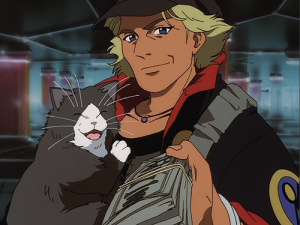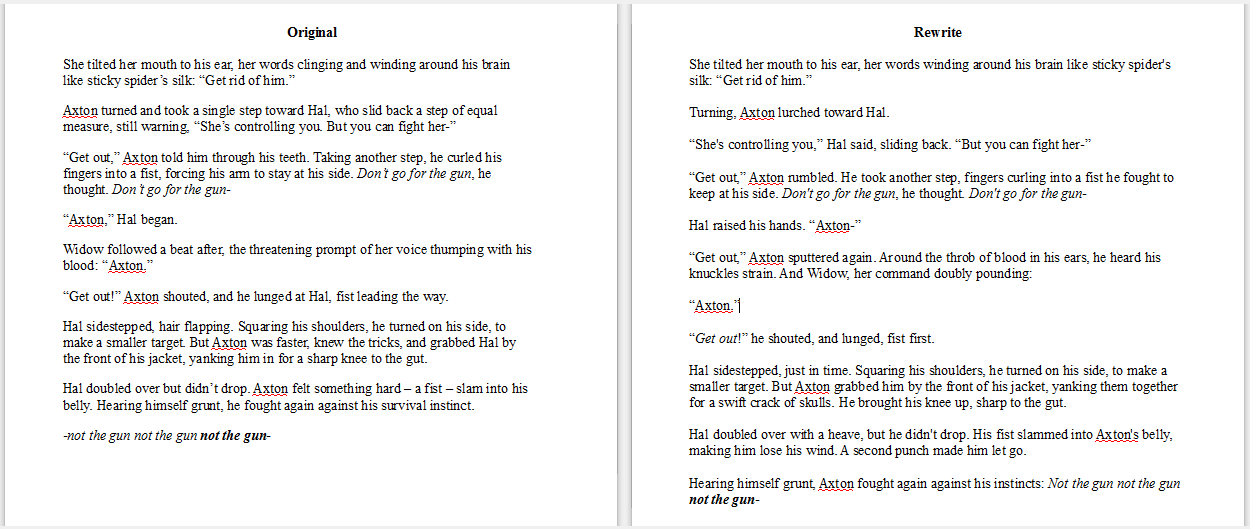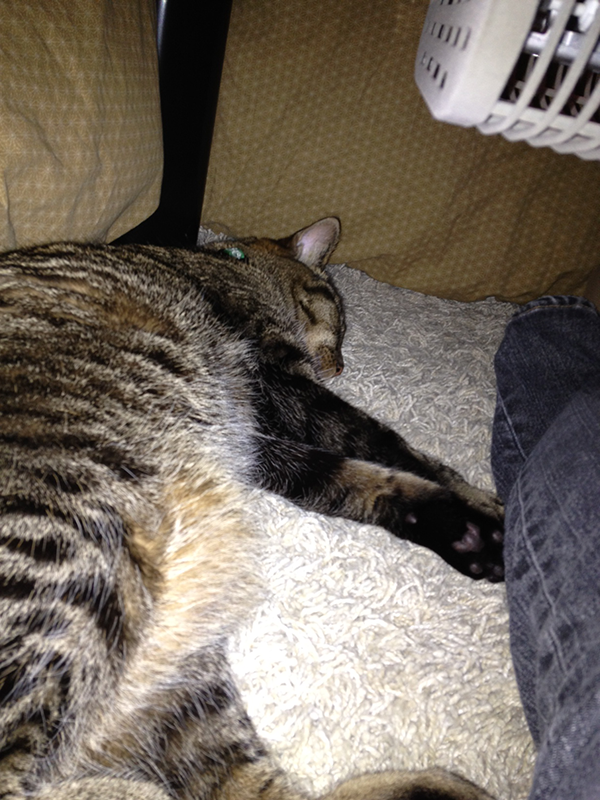by Mayumi-H | Dec 14, 2013 | Fearless, From Hell (A Love Story), Process
So, as some folks know, I’m writing this sci-fi western story based on a videogame universe. Blah blah blah, I know, it’s fan fiction and not real writing, whatever. I’m still having a blast with it, and just one of the reasons why is it’s given me a new perspective on some old characters.
For those who read “Anywhere but Here,” my 2012 NaNoWriMo project: Remember Tych and Imien? They were the pilot and the cypher, the secondary runaway characters following the two mains in the teenager half of the story. (Don’t worry if that’s confusing. It’s not important for this post.) Anyway, I came to a point in my current story, “From Hell,” where I needed a getaway ship. At first, I’d planned to model the ship’s captain on the character VT from the seventh session (episode) of the anime Cowboy Bebop, “Heavy Metal Queen.”

– screen capture: “Cowboy Bebop” –
If you’ve any interest in anime, sci-fi bounty hunter stories, or jazz music, check out Bebop. But, again, not important to this post.
In playing around with the different interaction scenarios between the main characters of “From Hell” and the ship’s captain, I realized the ship couldn’t have just one crew member. So, I developed a daughter for Janus (that was going to be the captain’s name). On the story went, but neither Janus nor the daughter character really took hold with me. The daughter, by the way, never even got far enough in my thought process to get a name. That should tell you something about how well that subplot was going.
One afternoon, I was sitting at my writing desk working on designs for the ship. (That went through a few permutations, too.) I stumbled across an old sketch I’d made of the Ridout, the smuggler’s ship from “Anywhere but Here.” Never one to pass up the opportunity to save the world from my terrible vehicle sketches, I considered my work on the new ship done. And, quite suddenly, it hit me.
I already had a smuggler crew, all ready to go, fleshed out and everything. Enter Tych and Imien…or, as I renamed them, Twitch and Ivory. I’d always liked the Tych and Imien characters, but their personal stories never got any deep attention in “Anywhere but Here,” focused as the story had been on the more major plight of four teenagers on the run from the galactic government. Bringing them into “From Hell” offered me a chance to examine their personalities in a more acute light. Plus, their own conflict, such as it is, relates well to that of the main characters…who are also on the run, now that I think about it, but that’s a thought for another time.
Of course, Tych and Imien had to go through some changes to make the jump from one universe to the other, but I couldn’t believe how stupid I’d been not to consider reusing these characters before! I’d borrowed pieces of other characters to create new ones before – I think every writer does that, at least at a subconscious level. For instance, the second principal character in “From Hell” – Hal, Axton’s engineer partner – developed from a mishmash of Amber from Fearless (cultured and sensitive, but also an elitist snob), and the Brock and Captain Aral characters from “Anywhere but Here” (sharp, loyal, a know-it-all techie, but afraid to pull a trigger). In turn, those characters developed from ones to come before them. I could draw up a whole family tree of where my characters come from…but it would probably be as confusing as the Baratheon/Lannister line of heirs!
I had to bring this up because I’m just having so much darn fun writing this story, and I wanted to share some of my excitement. I’ll go back to more serious stuff next time. Maybe.
Do you recycle characters?
by Mayumi-H | Dec 7, 2013 | Process, Short Stories
Earlier this week, LimebirdVanessa over at Limebird Writers posted the 25th edition of their Writing Competitions and Opportunities Digest. The series in itself is full of great opportunities for writers of all genres, interests, and skill levels, but one of them stood out in particular: the Confettifall Christmas Contest. Head on over to the Limebird Writers post to get the full details (and more!).
You back? Okay.
As you’ve read, the Confettifall Christmas Contest is to create a 140-character story. Confettifall’s site says there is no particular theme for this contest, so we could write whatever we wanted, with a few caveats (no profanity, no pornography, and no poems this time around). Ordinarily, these guidelines alone would hamper my ability to tell a story, but with only 140 characters to do the deed, I couldn’t waste my character count on foul words or play. I’m wordy enough as it is!
I wanted to have a very simple theme – romance/revenge – and a moment from my past struck me. On a lark, I’d gone to a palm reader with some friends of mine. We each had our pasts/futures read, with varying degrees of accuracy. The experience was mostly just a five-dollar jaunt into something silly we’d never done before, a fun way to pass the time while we waited for the guys in our party to show up. But, one line from my fortune teller stuck with me that night, and has continued to stay with me for many years. You’ll see what I mean….
Below is the process I took for this particular challenge. It’s pretty standard to my normal challenge process, though I’ve put in some of my internal monologue, just to keep things interesting:
Goal: Write a story in 140 characters.
First try:
The tarot reader had been spectacularly wrong on most counts: she had no children, no white picket fence, no important job. Certainly, the loving, faithful husband bit was a joke. But, the old woman had said one thing that had resonated with young Cecilia: “That which you cannot create, you are destined to destroy.”
Jace, her “loving” and “faithful” husband, never saw the shot coming.
Character count: 386. Okay, that’s way too long, but I’ve got an idea going. Now, to start whittling.
Second try:
While wrong on most counts, the psychic had made one correct prediction: What Cecilia couldn’t have, she’d destroy. Shame Jace didn’t hear it, too, or he’d have known about the gun.
Character count: 181. Not bad, but it doesn’t punch. And, 41 characters too many.
Third try:
What Cecilia couldn’t have, she would destroy. That had been her tarot reading.
Jace had called it cryptic nonsense. Maybe if he’d listened, she wouldn’t have shot him.
Character count: 167. I like this one better. It’s closer, but STILL too many characters. Need to whittle it down by 27.
Fourth try:
“What you can’t have, you will destroy,” the psychic said.
Her husband called such advice money-grabbing malarkey.
Maybe. She still shot him, though.
Character count: 147. I’m drifting into slightly more black comedy territory, here. Maybe not a bad idea.
Fifth try (Starting to wear thin):
“She told me, what I can’t have, I’ll destroy.”
“Bull,” her husband said, swinging his wandering eyes back to her.
“Really?” she said, and shot him.
Character count: 146. I’m starting to hate this contest. And my writing.
Sixth try:
“The psychic said, what I can’t have, I’ll destroy.”
“Bull,” her husband said, swinging his roving gaze her way.
Maybe. She still shot him.
Character count: 140 (tested in a Twitter window). Huzzah! Perhaps this isn’t prize-winning material, but I’ll leave this one where it stands. While fun in terms of a contest challenge, it’s not quite worth it to spend any extra time on.
The whole exercise took me about an hour, from first initial draft idea to what I came up with at the end. Even though this is an “official” contest with a prize and everything, I decided I wouldn’t spend more than an hour on it, just so it wouldn’t distract me all day from the rest of my writing projects. But, it was still fun.
What do you think? What sort of process do you go through for prompts/challenges like this? On a less writer-y note, have you ever had your fortune told?
by Mayumi-H | Oct 19, 2013 | From Hell (A Love Story), Process
A few weeks ago, I put up on the blog an excerpt of a fight scene I was having trouble with. Based on your feedback, I made some changes to the text, ones I hope create a smoother experience for the reader. Do they or don’t they? I’ll let you be the judge. (Clicking the image below will let you read both the original and updated versions, the latter of which I posted for readers just this past week, coincidentally enough.)

I like to think the update works better within the confines of the chapter…but I’m never sure. Because working from feedback has always been difficult, for me.
I like getting critique, especially if it can help my story become better: tighter, clearer, more effective. But, I spent a large part of my early writing life aping others. My sister first, then my favorite published authors. To this day, when I read books while I’m in the middle of writing a story, I find myself incorporating others’ techniques and quirks. It’s been said imitation is the sincerest form of flattery. Though, when does imitation go too far, and we lose our own voice to the art?
I like my voice. It varies from story to story (admittedly, less successfully when I drag out a story for too long), but I like thinking of my stories as my own. When I get critiqued – especially when it’s good critique – I always hesitate. “If I change this phrase to x, will I sound more like A? If I edit that section to y, is my voice becoming like B?”
Even though I may not be destined for publishing, I still want my story to be the best it can be. So, in some cases, writing like favorite author A or insightful reader B might be better. But, does that make a story less mine, less me? I don’t know.
In the face of solid critique, how do you remember to keep to your own voice?
by Mayumi-H | Oct 12, 2013 | Process
I recently read an article on “Why You Should have a Messy Desk,” and it got me to thinking about my work space. I often write where and when I can. That tends to be on my laptop or in my notebook, sitting in a chair or sofa somewhere in the house. There are times when I need to retreat, though, to get away from everything and truly concentrate. For those times, I go to my writing room, and my trusty kotatsu.
A kotatsu is a small table with a heater built underneath. Mine looks like this:
 This version of my kotatsu is much cleaner than it tends to get later in the colder months. Right now, I’ve just pulled it out from under about four piles of laundry. My scanner and portfolio are missing, too, because my husband made me put everything away when we had company a few months back. (No, I haven’t pulled them out since then. I haven’t really drawn since then, either, sadly. But that’s a lament for another day.)
This version of my kotatsu is much cleaner than it tends to get later in the colder months. Right now, I’ve just pulled it out from under about four piles of laundry. My scanner and portfolio are missing, too, because my husband made me put everything away when we had company a few months back. (No, I haven’t pulled them out since then. I haven’t really drawn since then, either, sadly. But that’s a lament for another day.)
The kotatsu might look like any other table…until you look under the blanket:
 That’s the neat little electric heater that makes everything under the blanket oh-so toasty. It’s a memory I have from childhood years in Japan that I was excited to recapture when I learned I could purchase a kotatsu here in the US. (And I could afford the purchase, of course.)
That’s the neat little electric heater that makes everything under the blanket oh-so toasty. It’s a memory I have from childhood years in Japan that I was excited to recapture when I learned I could purchase a kotatsu here in the US. (And I could afford the purchase, of course.)
The heat isn’t constant – it activates and deactivates on a regulated timer, based on your heat setting – but the blanket keeps the space warm. It’s not so energy efficient as a fireplace, but it’s more convenient than heating the whole house, especially when I’m alone. It’s pretty spacious under there, too. I’m short, so I can stretch my legs out, but even my six-foot-tall husband can get comfy underneath. He just can’t stretch out like I can. The only bad part about our kotatsu is that one of our cats seems to have a sixth sense for when I turn the thing on. And then, even I can’t stretch out as much as I’d like:
 There’s a specific warning on the kotatsu packaging that you should not let pets sleep under the lamp, because it can get quite hot…but you can’t keep a cat from heat. If you ever get a kotatsu, just turn it off when you step away for any length of time. The heat dissipates, and your cat will become chilled again. Probably miffed, too, but I can’t help you with that.
There’s a specific warning on the kotatsu packaging that you should not let pets sleep under the lamp, because it can get quite hot…but you can’t keep a cat from heat. If you ever get a kotatsu, just turn it off when you step away for any length of time. The heat dissipates, and your cat will become chilled again. Probably miffed, too, but I can’t help you with that.
Do you have a special place where you like to work?
by Mayumi-H | Sep 28, 2013 | Process
October is usually when I decide if I can and/or will participate in National Novel Writing Month. I like to have a vague idea of a story already in my head by that time, so I can use October to do the basics of my research. But, I have to know my starting point.
My first NaNo, all the way back in 2005, came from an idea to write about my ancestral homeland, Japan, through the eyes of the family cat. 2007 was the year I picked up a bass for the first time, and became obsessed with classic rock band The Who, and so based the story around music. My 2011 idea sprung from a conversation between a couple on a beach. In 2012, I totally pantsed my way through the story of my space-age runaways and the hounds on their tail. For 2013 – if I do participate – I’ve got a fairly rough outline already in mind, quoted below.
I guess you shouldn’t read the idea flow if you think you’ll read the finished product- BWAHAHAHAHAHA! Oh, oh, I had a good laugh at that one! Of course, no one is gonna wanna read this tripe!

Oh, come on. You laughed. I know you did.
But, here you go, a glimpse into my process:
Flashback: Paige
Present day: New possibilities
Rob and coffee (or a beer) (You’re no good at this)
Goodbye at the stoop/Take things slow/The kiss
Dinners and dates (Do you like him? Or, do you like like him?)
Serena (Blow-up at the restaurant)
The past – Rob and Serena
Love for the first time
The morning after (Sleepover rules)
Days pass
Serena’s fight (unfit for duty)
Paige always comes first (“She has to.”)
Goodbyes (You belong with her)
He’s not the same, without you (Mia, maybe)
Daddy?
Resolutions, reversals, and revolutions
Generally speaking, this is what a rough first outline looks like, for me. (Well, I usually start with character names and some sketches for appearance, but I didn’t think a bunch of random names and profile scribbles would have been interesting for a blog post.) The story may change from these initial flecks of grey matter – it often does! – but even in that case, I find I write much more easily and fluidly if I have some prepped ideas ready.
In 2012, I came to the game much later than I usually do – November 1, in fact – and I spent the first two days just writing a story flow outline. I got my highs and lows so early in the process, because I was writing great big chunks of dialogue to feed my plot brain. The remainder of the month was mostly just filling in the blanks of those dialogue blocks. Of course, it strayed in parts, but the basic story remained the same. I had a great time writing it, but I wonder if I did myself or the story an injustice because of the way it came together. An editor’s notes on the first chapter of that story showed me I hadn’t committed myself to the fullness of what that story could be. In some ways, I didn’t care, because it was a NaNo story and I was simply glad I’d gotten through it before November 30. But a more serious-minded, critical part of me thought I should have taken more of that time not merely filling in the spaces between the dialogue, but actually putting effort into building that world.
[youtube=http://www.youtube.com/watch?v=8IG8texwyYA&w=560&h=315]
(Not this sort of pantsing)
I’m still building that world. I don’t know if it will ever get to the point where I’d want to send it off again, but it gave me a lot to think about. That stories, the ones we love, deserve our full efforts.
I can’t say I’ll do any better with my 2013 story than I did with my 2012 one (or any of the others, for that matter), but part of the reason I like NaNo is that it makes me push myself to write, and write hard.
What do you think, based on the above? You think I should give single dad Rob and daughter Paige a chance?
How do you approach NaNo (if you do)?
by Mayumi-H | Sep 21, 2013 | Process
Some quick new fiction below. Request follows.
She tilted her mouth to his ear, her words clinging and winding around his brain like sticky spider’s silk: “Get rid of him.”
Axton turned and took a single step toward Hal, who slid back a step of equal measure, still warning, “She’s controlling you. But you can fight her-”
“Get out,” Axton told him through his teeth. Taking another step, he curled his fingers into a fist, forcing his arm to stay at his side. Don’t go for the gun, he thought. Don’t go for the gun–
“Axton,” Hal began.
Widow followed a beat after, the threatening prompt of her voice thumping with his blood: “Axton.”
“Get out!” Axton shouted, and he lunged at Hal, fist leading the way.
Hal sidestepped, hair flapping. Squaring his shoulders, he turned on his side, to make a smaller target. But Axton was faster, knew the tricks, and grabbed Hal by the front of his jacket, yanking him in for a sharp knee to the gut.
Hal doubled over but didn’t drop. Axton felt something hard – a fist – slam into his belly. Hearing himself grunt, he fought again against his survival instinct.
–not the gun not the gun not the gun–
An “action” scene from my latest venture. I’m trying hard to make these better with each permutation of my writing. There’s more, of course, but that would be spoiling things, wouldn’t it?
For those of you who write action, care to share your thoughts? Tips? Critique? I’m open to suggestions!







Recent Comments
The Real Person!
Author Mayumi-H acts as a real person and passed all tests against spambots. Anti-Spam by CleanTalk.
The Real Person!
Author Mayumi-H acts as a real person and passed all tests against spambots. Anti-Spam by CleanTalk.